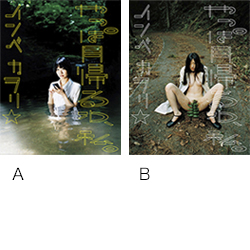
インベカヲリ★ 写真集
デザイン:山本知香子
Photographs by Kawori Inbe
Art Director : Chikako Yamamoto

About Book
インベカヲリ★、衝撃のデビュー作!!
10年にわたり撮り続けた全編女性のポートレイトが、圧倒的なエネルギーで見る者を挑発する。
被写体に応募してきた女性との対話を経て、インベカヲリ★はその心象風景を作り上げる。
「普通」を求める世の中への言葉にならない怒り、さらにその源にある自身への怒り、哀しみ。そこにしか生まれないユーモアやアイロニー。
「傷」や「弱さ」と思われがちな姿を、セッティングを通してカメラの前に晒すことで、ひとりひとりが固有の美しさと色気を漂わす。
背後の光景やポスターと渡り合う彼女たちのポートレイトは、インベカヲリ★が鋭く照らし出す「日本」でもある。
「人の人生を聞くのは楽しい。私の興味はまずそこにある。
被写体がどんな気もちで何を考えて、どんな過去とともに未来を見つめているか。個人のもつ人生物語からインスピレーションを得て、写真のイメージを膨らませていく。
写真を撮る上で、私は若さや美しさといった表面的な造作にはほとんど興味がない。それも人をつくり上げるひとつの要素だけれど、生きてきた過程で生まれるオリジナリティが見たい。平均化され、理想化されたものに個性はなく、むしろ一般論から外れたところにこそ、その人の思考や感性が現れると思っている。世間の常識を身にまとった姿を崩していったとき、その奥の姿が見えてくる。
リストカットなどの写真はビジュアルとしてインパクトがあるけれど、私は傷より顔が撮りたい。病気の症状は個性ではないので、現象よりもその目から感じる力に集中したいという思いが常にある。
女性を被写体に選ぶのは、日常の延長として撮られることの感覚をもっているからだ。男性の場合は、被写体となることに明解な理由をもち、完成された姿を見せたがる。逆に女性はもっと柔軟で、自分を客観視したい、違う角度から見たい、何か自己主張したいときなどにカメラの前に立つ感性をもっている。
写真集のタイトルである「やっぱ月帰るわ、私。」は、カメラの前で、そうした自分の根源にある心象風景を晒し、世間のうねりから抜け出していくさまを「竹取物語」に重ねて表現した。
あらゆる感情のなかでも、私は「怒り」の感情に生命力を感じるから、被写体から鋭い視線を引き出して撮りたくなる。劣等感や悲しみや絶望など、人生に抑揚をつける感情の根源にあるのは「怒り」だと思うし、自分自身に向けられる怒りの中には、外部からの抑圧、たとえば世間の常識や家庭環境や男性優位な社会や生まれた時代など、様々な抑圧に対する怒りが秘められている。怒りは主張だから、そうした言葉以外で見えてくる発言を撮りたくなる。
人間とは、その人のもつエネルギーのことだから、顔や体を超えた先にある魂を写したい。」(あとがきより)
The title of this work refers to the traditional Japanese "Tale of the Bamboo Cutter," about a magical princess who must eventually return to her home on the moon. Kawori Inbe says that her subjects harbor an "imaginary landscape" inside of themselves, suggesting that perhaps they might feel a connection to the princess of the story. Each photograph in this book shows a female subject, and Inbe has captured her subjects in poses that seem to hint at their inner lives. Inbe writes that she only photographs women because are "mor flexible" in front of the camera. Certainly, it would be hard to disagree with her after looking through the expressive images that she has captured here.Through her staging of her portraits--either the clothes her models are wearing, or the settings in which they are photographed--Inbe shows her subjects in their full power. This book was nominated for the 2014 Ihee Kimura Photography Prize. Includes English translation of a text by Kawori Inbe.
I like asking people about their lives. That is my first interest.
What my subject is feeling and thinking. How one thinks about the past and the future. I draw inspiration from the life stories people tell and fill the photos I take with those images.
When taking pictures, I have little or no interest in the superficial features of youth and beauty. Though admittedly those are components that have shaped that person, I seek the originality spawned from one's life experience. That which is homogeneous and idealized has no individuality. It's not until you get completely away from generalizations that one begins to show her thoughts and emotions. The inner person becomes visible only after their appearance clad in common sense has been destroyed.
The photos with slits wrists and the like are graphic, but I want to capture the face more than the injury. Symptions of a disease are not peculiar to any single person, so I always am focussing on the energy I see in the subject's eyes rather than what she is doing.
I choose to photograph women because they look like an extension of everyday life. Male subjects tend to perfect their appearance because they have a 'better side' they like to show.. Women, on the other hand, are more flexible; they get in front of a camera when they want to look at oneself objectively, see oneself from a different angle or ascert oneself in some sort of way.
The title of this photo collection -- It's time for me to go back ... to the moon -- plays off "The Tale of the Bamboo Cutter" as these women expose the imaginary landscape they harbor inside and flee the makings of this world in front of the camera.
Of all the emotions people have, I feel that "anger" manifests the will to live the most, so I want to draw out and capture a pointed look from subjects when shooting. I find "anger" to be the root of all emotions that temper life: a sense of inferiority, sorrow, despair, etc. Within the anger that one feels towards oneself lies an anger towards pressure from the outside that comes in various forms of oppression such as "common sense," "family environments," "male-oriented society" and "one's generation." Anger is ascertion, so I want to capture a statement that can be seen beyond words.
People are a product of the energy they have, so I want to capture the soul behind the face and body. (from the postscript)
Artist Information
インベカヲリ★|Kawori Inbe1980年、東京都生まれ。写真家。
2007年、新宿ニコンサロンにて個展「倫理社会」を開催。
2008年、ニコンサロンJuna21写真展年度賞「三木淳賞奨励賞」を受賞。
ロサンゼルス、バルセロナ、香港などでグループ展に参加、2012年~13年にかけてミラノで5ヶ月間の個展を開催。
2013年6月、パリのフリーマガジン「TEiCAM BOOKS」にて特集号が組まれる。
Photographer , born in Tokyo in 1980.
Staged solo exhibition at Shinjuku Nikon Salon in 2007.
Received the Annual Jun Miki Award at the Nikon Salon Juna 21 Exhibition in 2008.
Has shown at group exhibitions in Los Angeles, Barcelona and Hong Kong, and staged a solo 5 month-long solo exhibition in Milan over 2012 - 2013.
Assembled a special collection of works for the june 2013 feature issue of TEiCAM BOOKS, a free magazine in Paris.

